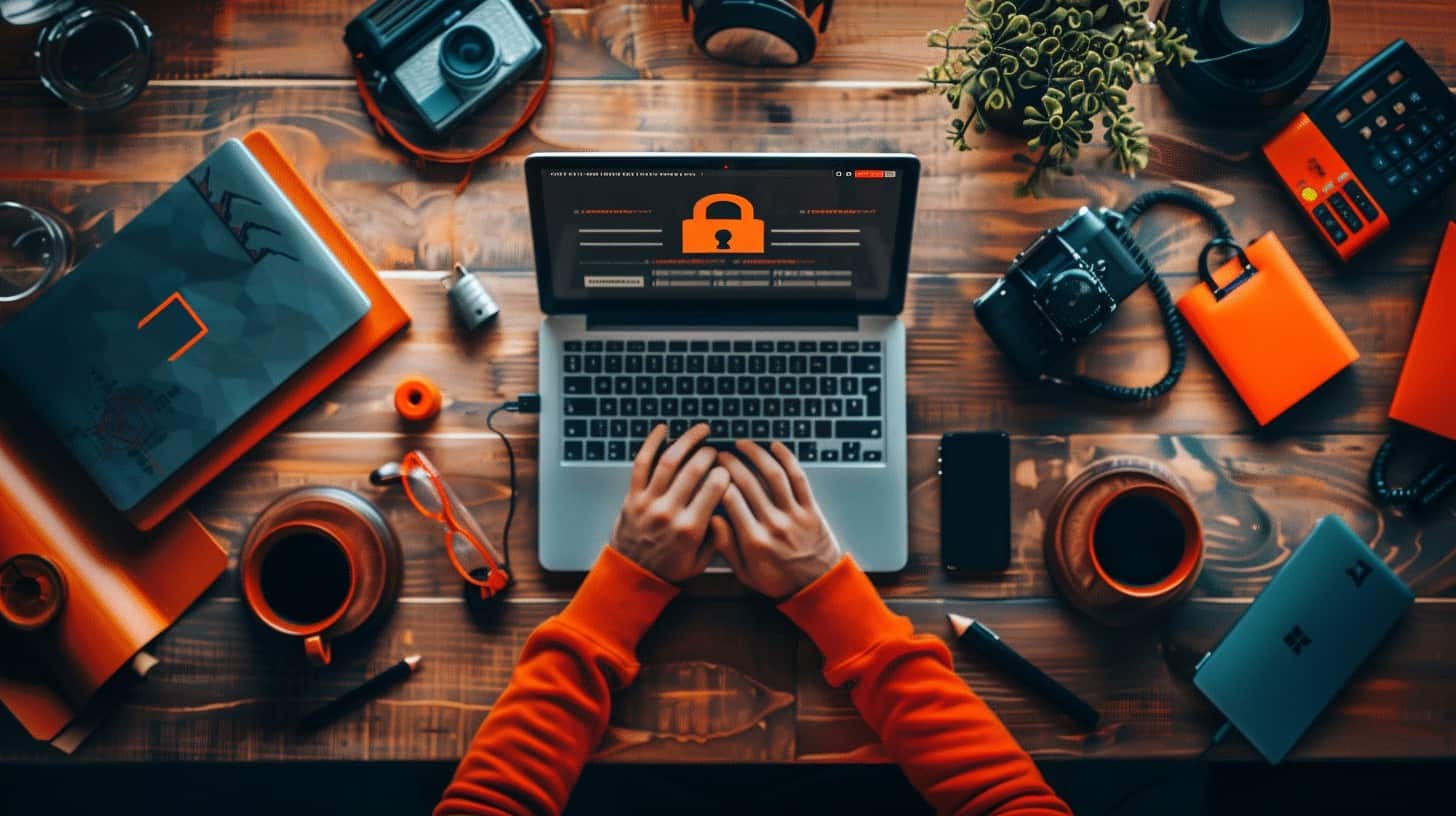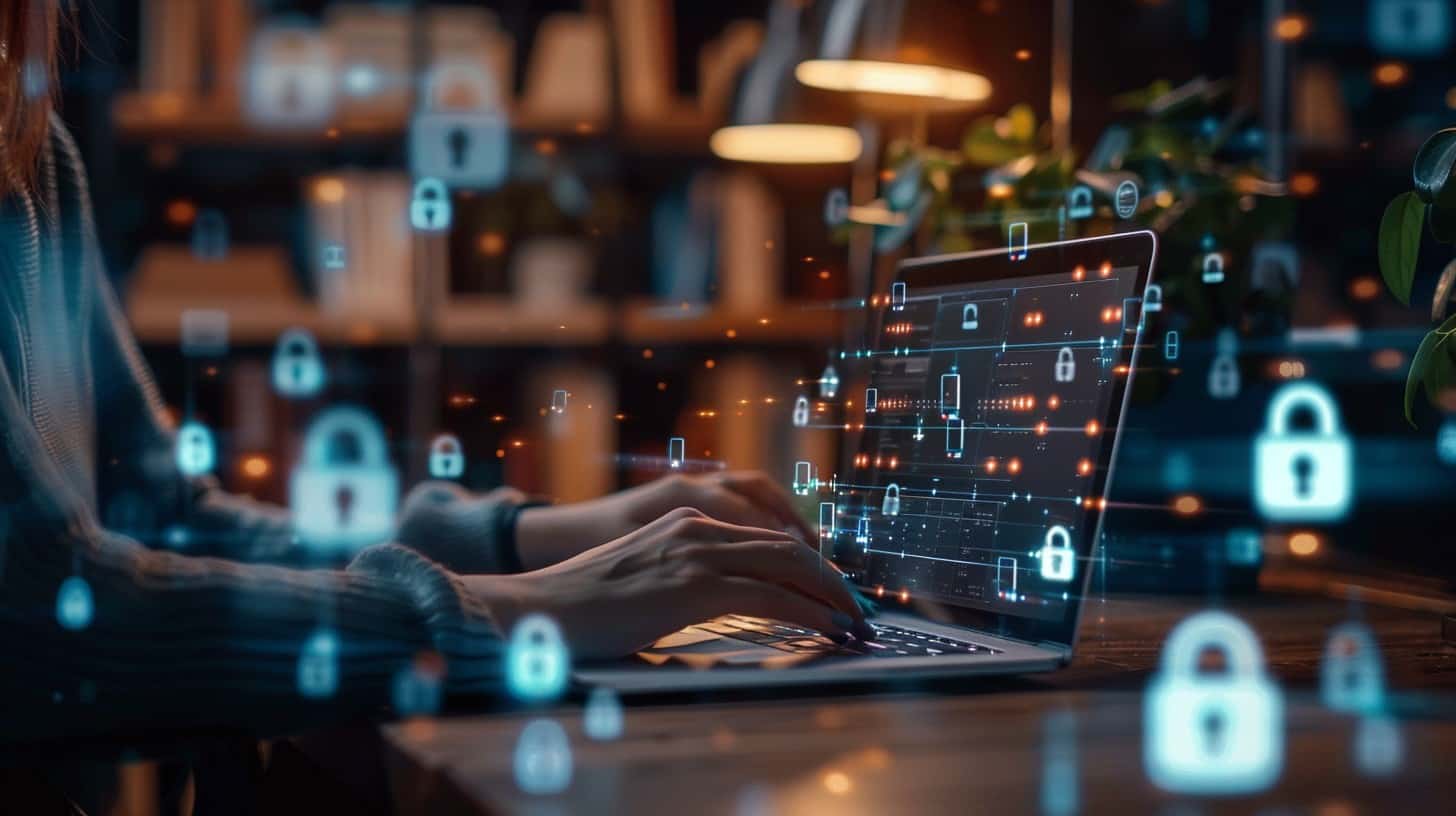Hey there, tech comrades and modern-day digital defenders! Ever had that moment of pure panic wash over you when it’s time to whisk your bank details into the online ether? Absolutely, same here.
I’ve squinted doubtfully at that ‘send’ button more times than I’d like to admit—quite the nail-biter. But hold on to your hats: after a deep dive into the depths of cyberspace (with trusty stats in hand, like “over 90% of malware is slung through email”), I’ve charted us a secure route for our treasured financial info.
Consider this post your cyber convoy for banking secrets; chock-full with savvy strategies to outwit those virtual villains lurking in the shadows trying to get you to Wire money you’ve worked so hard for.
And would you believe it? Safeguarding our fiscal chatter can be as smooth as scrolling through your favorite playlist—effortlessly digital! So, let’s roll up our sleeves (figuratively speaking) and stroll through some wisdom-packed prose…
Key Takeaways
Use strong passwords that mix letters, numbers, and symbols, and never share them with anyone. Change your passwords often and consider using a password manager.
Always verify the person’s identity before sending bank details by checking more than just their name—make a call or send a text to be sure.
Send sensitive information like bank details using end-to-end encryption services such as Proton Mail so only you and the receiver can read it.
Zip files with passwords before emailing them, and safely communicate the password through a secure channel or in person if possible.
Store files in encrypted cloud storage like Proton Drive for added security where even service providers cannot access your data.
Table of Contents
Understanding Sensitive Information

Hey there, fellow geeks! In the whirlwind world of digital planners and tech jobs, we often overlook a crucial aspect—getting savvy with sensitive information. It’s like grokking a new programming language; you’ve gotta know the basics to keep your data secure.
Whether it’s keeping your personal details under wraps or ensuring confidential business info stays on the down-low, understanding what counts as sensitive is step one in living anonymously in our Gmail-dominated universe…
And hey, who wouldn’t want to give those prying eyes a run for their money? Let’s dive into this together—it’ll be more fun than flipping through networking security books (and probably more helpful, too).
Personal information
So, we’re talking personal info here—like the stuff that says who you are. Your name, where you live, even your birthday can be like gold to scammers. It’s the key they need to unlock a whole mess of trouble in your life if they get their hands on it.
And bank details? That’s the jackpot for these guys! They could try to swipe money right out from under you.
Now, I’ve got my own set of rules for keeping this kind of sensitive data safe when sending it online. Totally swear by strong passwords and two-factor authentication (you know, that thing where it double-checks it’s really you?).
Also, a big fan of encryption tools like GPG or PGP—they make sure no one can snoop on what I’m sending over the internet. Sure keeps me sleeping easy at night!
Confidential business information
You know that secret recipe you would never want the world to find out? Well, think of confidential business information kind of like that. It’s the stuff companies must keep under lock and key – financial records, client lists, future plans.
If this info gets into the wrong hands, it could spell disaster; we’re talking major headaches like money loss or even legal troubles.
Keeping this kind of data safe is a top priority for any business. We’ve got to be super careful when sending it over the internet. Just imagine emailing your master plan only to have it intercepted by some sneaky hacker—that’s why encryption is such a big deal.
It jumbles up your sensitive details so well; only the right person with the key can make sense of it all again. I always make sure my bank info is scrambled into a digital puzzle before it hits cyberspace—better safe than sorry!
Government-classified information
Just like with business info, keeping government-classified information safe is super important. Let’s talk about top-notch ways to make sure this kind of data stays out of the wrong hands.
First up, always use strong passwords and two-factor authentication. It’s like having a secret code and then needing a special key to get in.
If you’ve heard about Proton Mail, you know it’s a big deal for sending stuff that needs to stay secret. It locks your emails so tightly that even the smartest hackers can’t peek inside.
And here’s another cool thing – there’s something called Proton Drive. This is where you can stash all your classified files and sleep tight knowing they’re wrapped up with end-to-end encryption nobody else can crack open.
Sending these sensitive secrets through email? You gotta watch out for those sneaky phishing attacks — they’re everywhere! But if you stick to secure email or other tools meant just for these kinds of jobs, bingo! You’ve got yourself a fortress protecting every word and number that matters.
Keep it locked up tight – think encrypted emails or cloud services that treat your info as if it were gold in Fort Knox!
Risks Associated with Sending Sensitive Information

Hey, you know what’s scarier than a horror movie? The thought of your bank info falling into the wrong hands because we slipped up online. Let’s be real – there are some pretty clever bad guys out there just waiting to pounce on any chance they get… and our innocent emails or cloud shares could be their golden ticket. So, before we hit ‘send’, let’s buckle up and talk strategy for keeping those digital dollars locked down tight!
Phishing attacks
Phishing attacks? They’re the sneaky emails that look like they come from a real bank or company, but they’re not. Cybercriminals craft them to trick us into giving away our private info like passwords and credit card numbers.
It’s kind of like someone fishing for your secrets—and if you bite, they’ve got you on the hook!
I’ve read about Proton Mail’s PhishGuard—pretty neat stuff. It helps protect against those phishing scams by checking if emails are coming from who they say they are. Dražen Vujovi? talks about this too on his blog; he knows his stuff when it comes to keeping email security tight.
No one wants their personal details snagged by some stranger with bad intentions, so these tools? Total lifesavers for staying ahead of the game and keeping our digital lives locked down tight.
Typing errors
Ever typed an email address, thought you nailed it, but bam – you sent your bank info to the wrong Bob? I’ve been there. Little mistakes like this can lead to big headaches. Imagine your banking details floating in someone else’s inbox because one letter got swapped.
Makes you sweat a bit, right?
It gets trickier with passwords and encryption keys. One slip-up while typing those, and it’s like leaving your house key under the doormat where any passerby can find it – not smart! Content Snare has our backs, though; their nifty reminders make sure we double-check our stuff before hitting send (props to Drazen Vujovic for that tip on his blog).
So let’s keep our eyes peeled for typos — they’re sneaky little buggers that can mess up more than just our autocorrect. Now, since we’re talking safe sends here, how secure is that email really without some top-notch encryption?
Lack of email encryption
Sending emails with bank info without encryption is like sending a postcard through the mail—anyone who gets their hands on it can read your personal stuff. Seriously, that’s risky business! Emails zip across servers and networks without any secret codes (that’s what encryption is all about) to keep prying eyes out.
Imagine this: you email your account number and sort code to pay for that cool gadget you found online… but along the way, someone sneaky grabs it. Not good.
I’ll tell ya, hackers love when we forget to encrypt our emails because it makes their job super easy. It’s like leaving your car unlocked with the keys in—it just invites trouble.
We need to lock down our messages with tough-to-crack codes so only the person we’re sending them to can read them. That’s where end-to-end encryption comes into play; ProtonMail’s got our backs on this one—with zero-access encryption technology that keeps everyone else in the dark.
Let me tell you how simple yet smart using encrypted services like ProtonMail can be before I dive into other safe ways of sharing sensitive information online…
Effective Ways to Send Bank Information Securely

Hey there, my savvy friends! So you’re itching to know how to beam over your bank deets without inviting cyber snoops to the party? I’ve got some killer tips up my sleeve that’ll lock down your info tighter than Fort Knox and keep those pesky digital thieves at bay—think secret agent-level security meets tech geek chic.
Hungry for more secrets of the trade? Keep reading.. (And hey, always remember: loose clicks sink ships!).
Using strong passwords and two-factor authentication
I’ve got to tell you, setting up strong passwords and two-factor authentication is like adding a beefy lock to your online safety vault. It’s a game-changer for keeping bank info safe and sound.
- Mix it up with passwords—combine letters, numbers, and symbols that no sly fox can guess.
- Don’t make it personal; using your dog’s name or your birthday is a no – go. Hackers love that stuff.
- Keep those passwords under wraps; never share them. Like secret family recipes, they’re for your eyes only.
- Change ’em regularly, just like you’d swap out old batteries to keep the juice flowing.
- Get into password managers. They’re like having a super smart assistant who remembers all the tough-to-crack codes for you.
- Two – factor authentication (2FA) isn’t double trouble—it’s double protection! You’ll need both your password and something else—like a code sent to your phone—to get in.
- Proton Mail knows the drill; they have 2FA that makes hackers sweat trying to break in.
Verifying the sender’s identity
So, let’s talk about making sure we’re sending info to the right person. You wouldn’t hand your house keys to a stranger, right? Same goes for bank details – gotta be super careful.
I like to double-check who’s on the other end before hitting send. It’s like Drazen Vujovic says in his blog, verifying someone’s identity is crucial.
Here’s my pro tip: don’t just look at the name, dig a bit deeper. A quick call or text can confirm you’ve got the right person. And hey, if they’re using something secure like Proton Mail that has end-to-end encryption – even better! That way, only you and them can read what’s sent.
No peeping Toms allowed!
Employing end-to-end encryption
Alright, now that we’ve made sure the person on the other side is who they say they are, let’s lock down our messages like a treasure chest. End-to-end encryption (E2EE) is like whispering in someone’s ear with a secret language only you two understand; even if someone else overhears it, all they get is gibberish.
It’s super important for keeping bank info safe from sneaky cyber thieves.
You see, when I use E2EE to send something as private as my banking details, it scrambles up the info into code until it reaches the right person with the key to unscramble it. Think of apps like Proton Mail—they’re like superheroes guarding your secrets with advance privacy shields and whatnot.
Plus, using tools that encrypt your words—like GPG or PGP—is smart tech talk for making sure no one but your chosen buddy gets to peek at what you’re saying. Keep those bank numbers locked tight in encrypted emails or PDF files; don’t just hand them out on a silver platter for hackers!
Password-protecting emails and attachments
Locking down my emails and attachments with a password is like putting a digital deadbolt on my private info. Imagine sending a secret note in class, but instead of just folding it up, I actually seal it with a unique code that only the person I’m passing it to can crack open.
Now picture doing this with bank details – pretty smart, right? Proton Mail gets this; they’re all about that end-to-end encrypted goodness, making sure nobody but me and the person I’m sending to can peek at what’s inside.
Now let’s chat about those steps for clamping down on our email contents. First off, we zip up those files good and tight with passwords before hitting send. Then comes the tricky part—how do we pass along that password without someone else snagging it? Well, secure messaging or even a quick phone call can keep that secret safe between us.
And hey, if you’re thinking bigger picture, using something like an encrypted cloud storage or client portal isn’t just throwing on another lock—it’s like adding an unbreakable safe into the mix!
Utilizing encrypted cloud storage
So, I’ve got secrets. Not the gossip kind, but bank info that’s gotta stay safe. Good thing is, encrypted cloud storage is like a superhero for my data. Picture this: I put my sensitive files in the cloud – think Google Drive or Dropbox – and bam! They’re turned into code that only the right key can unlock.
Even if some sneaky hacker grabs it midair or breaks into my account, without that key, they see gibberish.
Now, let me spill about Proton Mail; these folks take privacy up a notch with zero-access encryption. What does that mean? Simple: not even they can peek at what I store on their servers because everything gets scrambled from end to end.
And since we’re all about avoiding sticky situations here, there’s even something cool called message expiration. Yep – my sent information packs its bags and leaves after a while, just to make sure nobody overstays their welcome in my private business.
Keep those bank details tight as Fort Knox by zipping them away in an encrypted file before sending them sky-high to the cloud. Trust me; it’s way better than leaving your front door wide open with a sign saying ‘free money inside’.
FAQs About How to Send Bank Information Securely
How can I make sure my bank info stays safe when I send it online?
Ah, the eternal quest for safety in the wild west of the web! You’ve got to use transport layer security (TLS) – that’s your digital armor right there. It encrypts your private info so bad guys can’t read it if they get their grubby hands on it. And password-protect those emails like they’re treasure maps!
Should I just email my bank details through Microsoft Office or what?
Oh no, don’t you do that without some backup magic tricks! Use file encryption on Word docs or Excel sheets before you hit ‘send’. Think of it like wrapping up your secrets in a zillion layers of bubble wrap – only someone with the decryption key (like a super-secret passcode) can unwrap and peek inside.
Speaking of sending things, is using OneDrive or Google Drive cool for sharing private information?
You betcha! But only if you’ve turned on all those nifty privacy controls and made sure everything’s encrypted. Remember this: Don’t toss your sensitive stuff out there without locking it down first—like giving out keys to a locked diary.
So, email’s not always safe… Can I use messaging apps instead?
Sure thing—but pick one that promises end-to-end encryption, okay? That means everything you send turns into secret code from start to finish, and nobody else can snoop—even if they really want to.
Wait… What if someone tries to fake being me online?
That’s called spoofing, and trust me—it’s as sneaky as cats plotting world domination at midnight! Always check an email message’s source if something smells fishy, and never ever log in through links sent by strangers professing their undying love for your banking credentials!
Uh-oh… What happens if there’s a data breach after sending my info?
Time to be Sherlock Holmes! Keep an eye out for any odd transactions—and hey(!), change all passwords pronto-tonto. Banks are pretty good at dealing with these slip-ups but remember: The best offense is a great defense—so always stay ahead with top-notch security habits!



